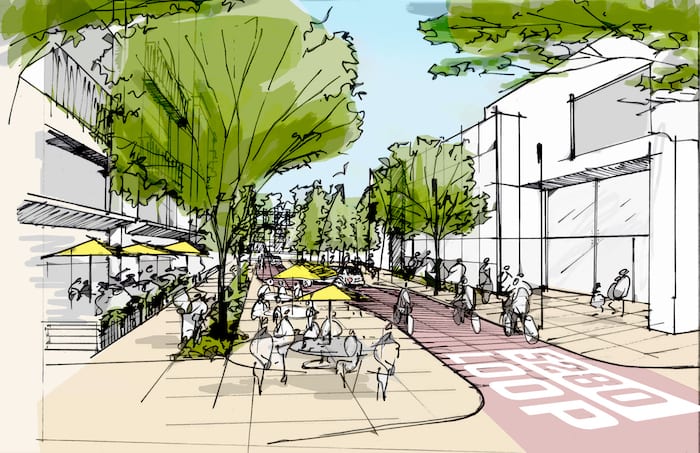5280 Loop: A New Take on Urban Placemaking

BUILDING DIALOGUE
The next trend in urban place making is taking place in Downtown Denver as we push design boundaries on the Downtown Denver Partnership’s 5280 Loop project. Inspired in part by New York City’s High Line, the Indianapolis Cultural Trail and numerous European precedents, the 5280 Loop seeks to create a 5.280-mile linear park and “urban trail” to connect Denver’s unique and diverse center city neighborhoods celebrating their cherished character. As a series of neighborhood places, the 5280 Loop will encourage city dwellers to get outside, explore and meet their neighbors. This new approach to park space consciously seeks to create a connective tissue of the downtown community and brings an urban manifestation of a mountain trail to life.
Born out of various individual neighborhood plans and comprehensive citywide plans, the 5280 Loop will actualize ideas and principles envisioned in these plans for creating a walkable and bicycle-friendly city. The planned route will connect Capitol Hill, the Golden Triangle, La Alma/Lincoln Park, Auraria Campus, LoDo, Five Points and Uptown while providing direct access to the most iconic parts of Denver including Denver Union Station, Coors Field, the Colorado Capitol Building, the Denver Art Museum, the Arts District on Santa Fe, the Tivoli Student Union, the Pepsi Center and more. The future design will embrace the distinct community characteristics of these adjacent neighborhoods and ensure vibrant shared public spaces.
The 5280 Loop explores and rethinks the traditional definition of a “street” beyond just moving vehicles. The Loop prioritizes people, place, pedestrians, and bicycles as a new way to occupy and navigate an ever-densifying urban core. The Loop’s conceptual design strategically links existing special spaces and places, as well as identifying underutilized roadways that can be completely transformed creating new iconic “shared spaces.” At the same time, the new connections will promote community and celebrate the urban experience in an authentically Denver way.
Envisioned as a linear park, the proposed urban trail would repurpose whole streets in some areas currently reserved for cars and retrofit them to prioritize people in others. That could mean almost entirely car-free streets on some segments, or the creation of “woonerfs” – a Dutch concept of shared public space – where bikes and people mingle with cars driving cautiously. At its minimalist intervention, the 5280 Loop will be an above-curb, protected multiuse path – flanked by shade trees and green space, which could open onto plazas with patio seating and play areas for children. As important to the design thinking as what “it” is; is what “it” isn’t. The 5280 Loop isn’t intended as a high-speed, personal transportation link into the city center; rather it is a leisurely stroll through our beloved neighborhoods.

The 5280 Loop is a grand, park promenade connecting the neighborhood and city to LaAlma/Lincoln Park.
Ultimately, this project is about place making and cultural identity, not pushing singular design through each neighborhood. Civitas and the Downtown Denver Partnership have worked closely with neighborhood residents and a robust stakeholder group to develop an overarching design vision that celebrates the unique physical, social and cultural identity of each community. Materiality and landscape will play a critical role in unifying the entire loop. However, Civitas is working to carefully select a palette that will allow the flexibility to adapt to each neighborhood’s unique vision as well as the ability to “go quiet,” acting as a slender ribbon through an existing place, or expand, creating a woonerf or new plaza.
The nature of the 5280 Loop as an urban trail reimagines the public right-of-way. Unlike an elevated park or rails-to-trails project, it will be essential to redesign intersections where critical transportation functional overlaps can occur – reducing speeds and heightening awareness of the interactions between pedestrians, bicycles, personal automated transportation and vehicles. This necessity gets at the basic theory behind the redesign: creating a 21st-century urban circulation network that marries the principles of health, place making, landscape, mobility and people.
Aligned with Civitas’ mission of creating healthier cities, the 5280 Loop design also uses an outcome-based approach that demonstrates the relationship between specific design strategies and health-related outcomes. To further correlate design and health, we enlisted nationally known public health expert and HealthxDesign founder Rupal Sanghvi. Dr. Sanghvi believes the 5280 Loop “has the potential for impacting a population of some magnitude” and views the project as a potential model for “thinking more upstream” in promoting health through the physical shape of how we live, work and play.
With the 5280 Loop’s confluence of health, safety and connectivity, the collaboration between the Downtown Denver Partnership, Civitas, and the city and county of Denver on the shared-space design is placing Denver at the forefront of reimagining the public right-of-way and redefining how we might share the road for social as well as physical health. With numerous neighborhood input and stakeholder sessions completed, the conceptual design for the 5280 Loop – identifying the route and articulating key locations for green space, community gardens, public art, important views, and opportunities for new public spaces all within the right of way – is slated for completion by the fall. With the conceptual design completed, there will be opportunities for additional showcase blocks, and semipermanent installations of concepts to push the momentum forward.
Published in the September 2018 issue of Building Dialogue.













